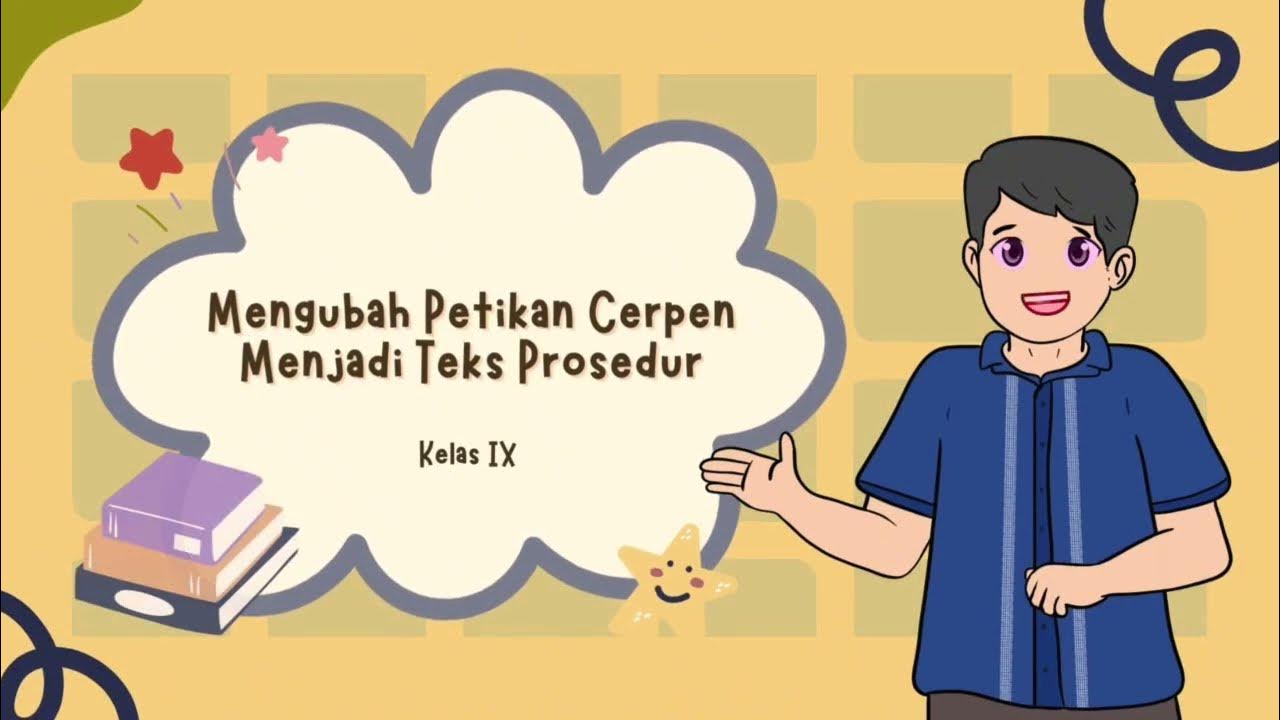Video Pembelajaran Bahasa Indonesia Materi Teks Prosedur kelas 7 SMP/MTs
Summary
TLDRThis video provides a clear and engaging lesson on procedural texts ('teks prosedur') in Indonesian. It covers the definition, purpose, characteristics, and types of procedural texts, explaining how these texts outline a series of steps for completing a task. The video also highlights three types of procedural texts: simple, complex, and protocol, with examples such as making instant noodles, preparing official documents, and using household appliances. The lesson aims to help viewers understand how to follow and write procedural instructions effectively.
Takeaways
- 😀 Text procedures are a set of instructions or steps used to perform an activity or operation.
- 😀 The purpose of a text procedure is to guide the reader or viewer through a process, ensuring they can achieve a desired outcome.
- 😀 A key feature of a text procedure is the use of imperative sentences like commands, suggestions, or prohibitions.
- 😀 Text procedures provide a systematic sequence of steps, often arranged in a clear and logical order.
- 😀 They typically include rules or limitations regarding materials or the process to be followed.
- 😀 The steps in a procedure must be outlined in a manner that is easy to follow and understand.
- 😀 There are three main types of text procedures: simple procedures, complex procedures, and protocol procedures.
- 😀 Simple procedures are short and involve only a few steps, such as using an iron or cooking instant noodles.
- 😀 Complex procedures involve multiple steps arranged hierarchically, such as applying for a national ID or preparing a traditional dish.
- 😀 Protocol procedures are more flexible and easy to understand, typically involving more than three steps, like using a washing machine or cooking rice.
- 😀 Understanding these types of procedures helps improve one's ability to follow or create instructional content effectively.
Q & A
What is a procedural text?
-A procedural text is a type of text that explains a series of steps or instructions to complete a task or process. It provides clear and sequential directions to achieve a specific goal.
What is the purpose of a procedural text?
-The purpose of a procedural text is to explain the steps or actions required to perform a task so that the reader or viewer can follow the instructions accurately and successfully complete the process.
What are the main characteristics of a procedural text?
-The main characteristics of a procedural text include: 1) Using imperative sentences (commands, suggestions, or prohibitions); 2) Providing a clear sequence of steps; 3) Including rules or limits on materials or methods; 4) Steps arranged systematically and in order.
Can you explain the three types of procedural texts mentioned in the video?
-The three types of procedural texts are: 1) Simple procedural texts, which involve few steps and are straightforward (e.g., making instant noodles); 2) Complex procedural texts, which involve multiple stages or detailed instructions (e.g., applying for an ID card); 3) Protocol procedural texts, which are easy to understand and typically involve more than three steps (e.g., using a washing machine).
What is an example of a simple procedural text?
-An example of a simple procedural text is the procedure for using a flat iron or making instant noodles. These involve only a few simple steps.
What makes a procedural text 'complex'?
-A procedural text is considered 'complex' when it includes numerous steps, with each step building on the previous one. These texts are often used for tasks that require multiple stages, such as applying for an ID card or cooking a complex meal like nasi kuning (yellow rice).
What distinguishes a protocol procedural text from other types?
-Protocol procedural texts are characterized by their simplicity and clarity. They often involve more than three steps but are easy to follow, with clear instructions that are not overly complex. Examples include using a washing machine or making spaghetti.
Why is the use of imperative sentences important in procedural texts?
-Imperative sentences are essential in procedural texts because they provide clear instructions and direct commands. These sentences guide the reader on exactly what action to take, ensuring the process is followed correctly.
What role do materials or limitations play in procedural texts?
-Materials or limitations in procedural texts serve to outline the resources needed for the task and set boundaries for the procedure. This ensures that readers know what tools or ingredients are required and what should or should not be done during the process.
How are the steps in a procedural text organized?
-The steps in a procedural text are organized in a clear, logical sequence, often numbered or listed in order. This systematic arrangement ensures that the reader can follow the instructions without confusion, completing each step in the correct order to achieve the desired result.
Outlines

Esta sección está disponible solo para usuarios con suscripción. Por favor, mejora tu plan para acceder a esta parte.
Mejorar ahoraMindmap

Esta sección está disponible solo para usuarios con suscripción. Por favor, mejora tu plan para acceder a esta parte.
Mejorar ahoraKeywords

Esta sección está disponible solo para usuarios con suscripción. Por favor, mejora tu plan para acceder a esta parte.
Mejorar ahoraHighlights

Esta sección está disponible solo para usuarios con suscripción. Por favor, mejora tu plan para acceder a esta parte.
Mejorar ahoraTranscripts

Esta sección está disponible solo para usuarios con suscripción. Por favor, mejora tu plan para acceder a esta parte.
Mejorar ahoraVer Más Videos Relacionados

PRAKTIK MENGAJAR JARAK JAUH MATERI TEKS PROSEDUR

Kelas 9 (Kurmer) || Bab 2 || 1. Pengertian, Ciri, dan Struktur Teks Prosedur

Soal UAS/PAS BAHASA INDONESIA Kelas 11 Semester 1 Tahun 2023 #BAHASAINDONESIA #Kelas11 #semester1

TEKS PROSEDUR PART 1 | KURIKULUM MERDEKA | BAHASA INDONESIA KELAS IX | BELAJAR ONLINE | FITRI RIZKY

MODEL PEMBELAJARAN TEKS PROSEDUR

Mengubah Petikan Cerpen Menjadi Teks Prosedur | Video Kreatif | Nobel Rajendra Riyanto
5.0 / 5 (0 votes)
